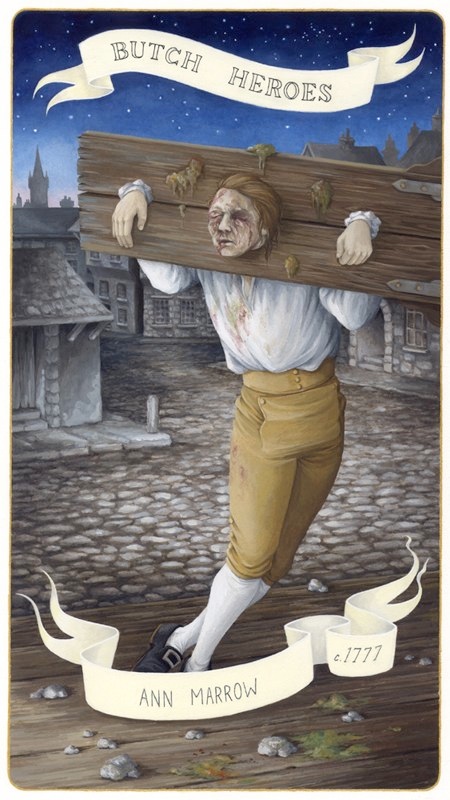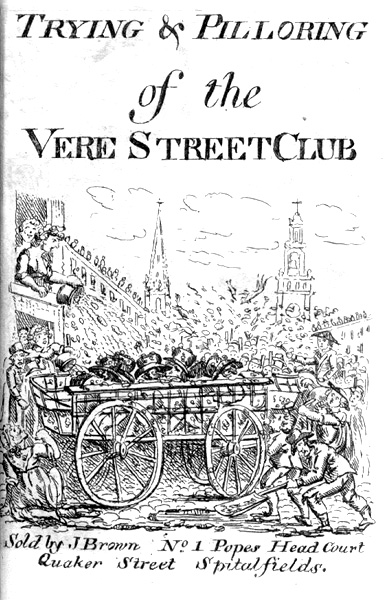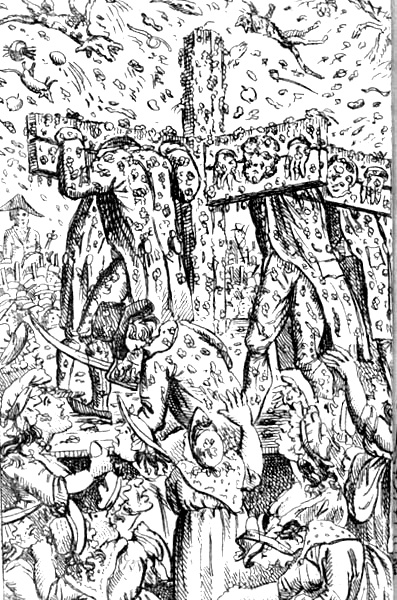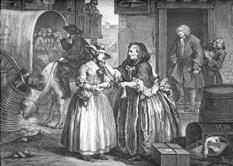Sexual offences
Sexual offences usually provoked the crowd to demonstrate their extreme disapproval. Here are
extracts from academic works which discuss the use of the pillory in this context.
Public secrets: sodomy and the pillory
in the eighteenth century and beyond
Sodomites in the Pillory in 18th Century London
The following are notorious examples of the pillory (and other methods) being used to punish
homosexual offences:
Mary Hamilton

In 1746 Mary Hamilton, alias Charles, George, and William Hamilton, was tried for fraud at the Quarter
Sessions at Taunton in Somerset, for posing as a man and marrying a woman. In reality Mary had had a number
of relationships with various women. It was claimed at the trial that she had married fourteen women.
Mary was duly convicted of fraud. In sentencing her, the judge stated: “he or she prisoner at the bar is an
uncommon, notorious cheat, and we, the Court, do sentence her, or him, whichever he or she may be, to be imprisoned
six months, and during that time to be whipped in the towns of Taunton, Glastonbury, Wells and Shipton Mallet”.
During the winter of 1746, Mary was stripped to the waist and publicly flogged in those four market towns. After
serving her time in prison, Mary emigrated to Philadelphia....where she claimed to be a doctor and faced further
fraud charges.
Ann Marrow

Here is a contemporary newspaper report about Ann Marrow, who was convicted
of fraud, cross dressing, and entering into three marriages with other women:
"Pilloried at Charing Cross, 22nd of July, 1777, for marrying three Women.
Ann Marrow was convicted at the Quarter Sessions for the city and liberty of
Westminster, on the 5th of July, 1777, of going in men's clothes and personating
a man in marriage, with three different women (Mary Hamilton, the reader will
remember, played off this trick fourteen times), and defrauding them of their
money and effects. She was sentenced to be imprisoned three months, and during
that time to stand once in and upon the pillory, at Charing Cross.
Agreeably to the pillorying part of her sentence she was on the 22nd of the
same month, placed in the pillory; and so great was the resentment of the
spectators, particularly the female part, that they pelted her to such a degree
that she lost the sight of both her eyes."
Vere Street Coterie
In 1810, six men (known as the Vere Street Coterie) were sentenced to the pillory
for homosexual offences. The following contemporary newspaper reports provide a graphic description
of the treatment they received:
"The disgust felt by all ranks in Society at the detestable conduct of these wretches occasioned many
thousands to become spectators of their punishment. At an early hour the Old Bailey was completely
blockaded, and the increase of the mob about 12 o'clock, put a stop to the business of the sessions.
The shops from Ludgate Hill to the Haymarket were shut up, and the streets lined with people, waiting
to see the offenders pass. Four of the latter had been removed from the House of Correction to Newgate
on Wednesday evening, and being joined by Cook and Amos, they were ready to proceed to the place of punishment.
A number of fishwomen attended with stinking flounders and entrails of other fish which had been in
preparation for several days.
The gates of the Old Bailey were shut and all strangers turned out. The miscreants were then brought out,
all placed in the caravan. Amos began to laugh, which induced his companions to reprove him, and they all
sat upright, apparently in a composed state, but having cast their eyes upwards, the sight of the spectators
on the tops of the houses operated strongly on their fears, and they soon appeared to feel terror and dismay.
 At the instant the church clock went half-past twelve, the gates were thrown open. The mob at the same
time attempted to force their way in, but they were repulsed. A grand sortie of the police was then made.
About 60 officers, armed and mounted as before described, went forward with the City Marshals. The caravan
went next, followed by about 40 officers and the Sheriffs. The first salute received by the offenders was
a volley of mud, and a serenade of hisses, hooting, and execration, which compelled them to fall flat on
their faces in the caravan. The mob, and particularly the women, had piled up balls of mud to afford the
objects of their indignation a warm reception.
At the instant the church clock went half-past twelve, the gates were thrown open. The mob at the same
time attempted to force their way in, but they were repulsed. A grand sortie of the police was then made.
About 60 officers, armed and mounted as before described, went forward with the City Marshals. The caravan
went next, followed by about 40 officers and the Sheriffs. The first salute received by the offenders was
a volley of mud, and a serenade of hisses, hooting, and execration, which compelled them to fall flat on
their faces in the caravan. The mob, and particularly the women, had piled up balls of mud to afford the
objects of their indignation a warm reception.
At one o'clock four of them were exalted on a new pillory, made purposely for their accommodation. The
remaining two, Cook and Amos, were honoured by being allowed to enjoy a triumph in the pillory alone.
Upwards of fifty women were permitted to stand in the ring [in front of the pillory], who assailed them
incessantly with mud, dead cats, rotten eggs, potatoes, and buckets filled with blood, offal, and dung,
which were brought by a number of butchers' men from St James's Market. These criminals were very roughly
handled; but as there were four of them, they did not suffer so much as a less number might.
After an hour, the remaining two, Cook and Amos, alias Fox, were desired to mount and in one minute they
appeared a complete heap of mud and their faces were much more battered than those of the former four.
Cook appeared almost insensible, and it was necessary to help him both down and into the cart, whence
they were conveyed to Newgate by the same road they had come. As they passed the end of Catherine Street,
Strand, on their return, a coachman stood upon his box, and gave Cook five or six cuts with his whip.
From the moment the cart was in motion, the fury of the mob began to display itself in showers of mud and
filth of every kind. Before the cart reached Temple Barm, the wretches were so thickly covered with filth,
that a vestige of the human figure was scarcely discernible. They were chained, and placed in such a manner
that they could not lie down in the cart, and could only hide and shelter their heads from the storm by
stooping. This, however, could afford but little protection. Some of them were cut in the head with brick-bats,
and bled profusely. The streets, as they passed, resounded with the universal shouts and execrations of the
populace."
 Another newspaper described this incident thus:
Another newspaper described this incident thus:
"Such was the degree of popular indignation excited against these wretches, and such the general eagerness to
witness their punishment, that, by ten in the morning, the chief avenues from Clerkenwell Prison and Newgate
to the place of punishment were crowded with people; and the multitude assembled in the Haymarket, and all its
immediate vicinity, was so great as to render the streets impassable. All the windows and even the very roofs
of the houses were crowded with persons of both sexes; and every coach, wagon, hay-cart, dray, and other
vehicles which blocked up great part of the street, were crowded with spectators.
The Sheriffs, attended by two City Marshals, with an immense number of constables, accompanied the procession
of the Prisoners from Newgate, whence they set out in the transport caravan, and proceeded through Fleet-street
and the Strand; and the Prisoners were hooted and pelted the whole way by the populace. At one o- clock four of
the culprits were fixed in the pillory, erected for and accommodated to the occasion, with two additional wings,
one being allotted for each criminal; and immediately a new torrent of popular vengeance poured upon them from
all sides.
The day being fine, the streets were dry and free from mud, but the defect was speedily and amply
supplied by the butchers of St. James's- market. Numerous escorts of whom constantly supplied the party of attack,
chiefly consisting of women, with tubs of blood, garbage, and ordure from their slaughter-houses, and with this
ammunition, plentifully diversified with dead cats, turnips, potatoes, addled eggs, and other missiles, the
criminals were incessantly pelted to the last moment. They walked perpetually round during their hour [the pillory
swivelled on a fixed axis]; and although from the four wings of the machine they had some shelter, they were
completely encrusted with filth.
Two wings of the Pillory were then taken off to place Cooke and Amos in the two remaining ones, and although
they came in only for the second course, they had no reason to complain of short allowance, for they received
even a more severe discipline than their predecessors. On their being taken down and replaced in the caravan,
they lay flat in the vehicle; but the vengeance of the crowd still pursued them back to Newgate, and the caravan
was so filled with mud and ordure as completely to cover them.
No interference from the Sheriffs and Police officers could refrain the popular rage; but notwithstanding the
immensity of the multitude, no accident of any note occurred."
Source: Rictor Norton, "The Vere Street Coterie", The Gay Subculture in Georgian England.
Bawdy Houses
Those who ran bawdy houses (brothels) were also regular visitors to the pillory,
as the following contemporary newspaper reports attest:
27 June 1719 - "On Thursday last Mary Terry, alias Evens, and Elizabeth Bourne, alias Whalley, alias Conelly,
convicted for keeping notorious bawdy-houses, stood in the pillory at Charing-Cross, where they were treated with
the highest resentment of the mob on those occasions, in showers of rotten eggs, dirt, &c.
And this day they are to be whipt, as we hear, round Covent-Garden: Besides which, they are sentenc’d to be imprison’d
and fin’d." (Weekly Journal, or, British Gazetteer)
27 June 1719 - "Last week, at the King’s Bench Court, Westminster, one Elizabeth Carey, of the Parish of
St. Martin’s in the Fields, having been found guilty of ten indictments, in keeping a disorderly house, was fined
for eight of them half a Crown each, for the ninth to stand on the pillory, and for the
tenth to be whipt from Charing-Cross to Somerset-House. Mary Whaley, of the said Parish, being also convicted of
six indictments for the same offence, was for the first four fined half a Crown each, and for
the fifth and sixth to be pilloried and whipt in the like manner as Elizabeth Carey." (Original Weekly Journal)
27 June 1719 - "On Thursday Elizabeth Carey and Mary Whaley stood on the pillory at Charing Cross, for
keeping bawdy-houses, pursuant to their sentence afore-mentioni’d. Whaley had the impudence, when she mounted, to
say, that if all her sex were to be punished in the like manner for venial offences, she
doubted whether all the timber in Norway would be sufficient to make pillorys for them." (Original Weekly Journal)
18 February 1720 - "On Monday last Mr. Kettleby moved the Court of King’s-Bench very strenuously, on behalf
of Mrs. Hayward, who is sentenced to stand in the pillory for keeping a leud and disorderly house, for a longer
respite than the Court had granted, because it was affidavited that she was far gone with child, and that it might
endanger her life; and the Court directed that the Sherriff should execute the sentence
at a convenient time." (London Journal)
18 February 1721 - "The execution of the sentence pass’d on Richard Haywood and his wife, for keeping a disorderly
house, is deferr’d for some days." (Applebee’s Original Weekly Journal)
18 March 1721 - "Saturday one Hayward and his wife, lately convicted for keeping a house of ill fame, stood in
the pillory in Covent-Garden." (Weekly Journal, or British Gazetteer)
25 September 1752 - "Yesterday a woman was try’d before the Court of Lord-Mayor and Aldermen at Guildhall, for
keeping a notorious bawdy-house in the Old-Baily, when, after a short hearing, (it being proved that she was an old offender)
was sentenced to stand in the pillory, and suffer six months imprisonment." (General Advertiser)
Source: Rictor Norton, Early Eighteenth-Century Newspaper Reports: A Sourcebook, "Bawdy Houses"
Mother Needham
 Probably the most infamous brothel-keeper was Elizabeth Needham, popularly known as Mother Needham. She was immortalised in Hogarth’s “The Harlot’s Progress” (see illustration), where she is depicted trying to recruit a girl to work in her brothel.
Probably the most infamous brothel-keeper was Elizabeth Needham, popularly known as Mother Needham. She was immortalised in Hogarth’s “The Harlot’s Progress” (see illustration), where she is depicted trying to recruit a girl to work in her brothel.
After many years of successfully plying her trade, Needham was eventually arrested and brought before the court on 29 April 1731. She was convicted “for keeping a disorderly house in Park-place, S. James’s, was fined 1s. to stand twice in the pillory, and to find sureties for her good behaviour for 3 years”. (Grub-street Journal)
On 5 May 1731 “the noted Mother Needham stood in the pillory in Park-place near S. James’s-street; and was severely handled by the populace. (Daily Journal) “She was so very ill, that she laid along under the pillory, notwithstanding which she was severely pelted, and it is thought she will die in a day or two.” (Post-Boy)
.jpg) A contemporary poem commemorated Needham’s stint in the pillory:
A contemporary poem commemorated Needham’s stint in the pillory:
“Rais’d on a precipice of wood,
With woeful arms extending,
An hour the pious matron stood
The force of dogs, and cats, and mud,
Sound eggs and rotten, blending.”
Needham died of her injuries before she could complete her sentence. “She declared in her last words, that what most affected her was the terror of standing in the pillory to-morrow in New Palace-Yard, having been so ungratefully used by the populace on Wednesday.” (Whitehall Evening Post)
Source: Rictor Norton, Early Eighteenth-Century Newspaper Reports: A Sourcebook, "Bawdy Houses"

[Return to index page]
Last modified 25 April 2019.
Copyright © StocksMaster. All rights reserved.
 At the instant the church clock went half-past twelve, the gates were thrown open. The mob at the same
time attempted to force their way in, but they were repulsed. A grand sortie of the police was then made.
About 60 officers, armed and mounted as before described, went forward with the City Marshals. The caravan
went next, followed by about 40 officers and the Sheriffs. The first salute received by the offenders was
a volley of mud, and a serenade of hisses, hooting, and execration, which compelled them to fall flat on
their faces in the caravan. The mob, and particularly the women, had piled up balls of mud to afford the
objects of their indignation a warm reception.
At the instant the church clock went half-past twelve, the gates were thrown open. The mob at the same
time attempted to force their way in, but they were repulsed. A grand sortie of the police was then made.
About 60 officers, armed and mounted as before described, went forward with the City Marshals. The caravan
went next, followed by about 40 officers and the Sheriffs. The first salute received by the offenders was
a volley of mud, and a serenade of hisses, hooting, and execration, which compelled them to fall flat on
their faces in the caravan. The mob, and particularly the women, had piled up balls of mud to afford the
objects of their indignation a warm reception. 

 Another newspaper described this incident thus:
Another newspaper described this incident thus:
.jpg) A contemporary poem commemorated Needham’s stint in the pillory:
A contemporary poem commemorated Needham’s stint in the pillory: